Colourful Spring |
||||||||||||||||||||||||||||||||||
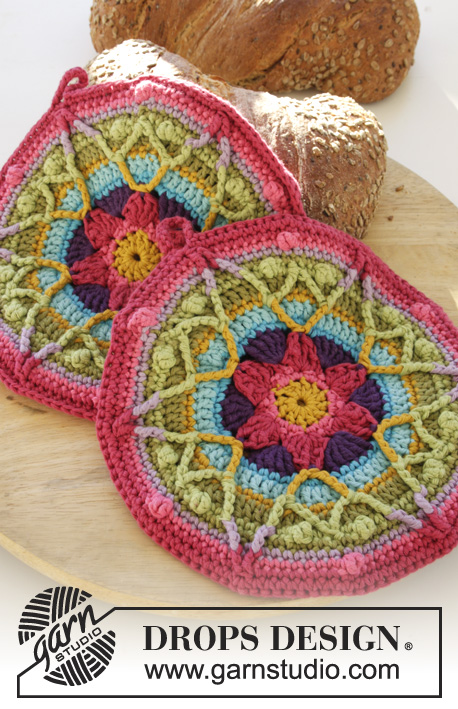 |
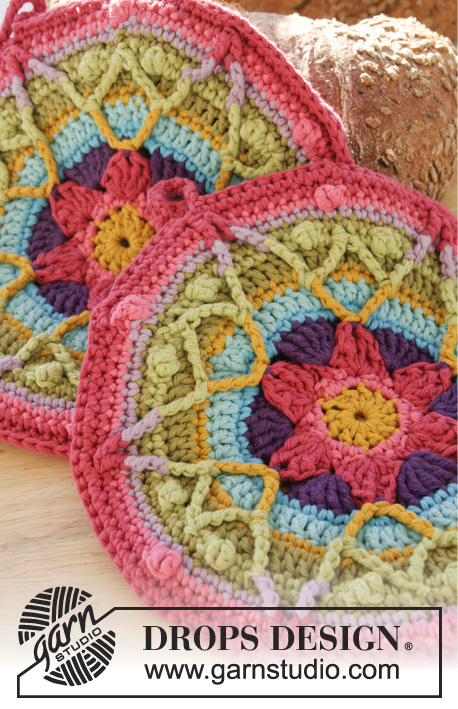 |
|||||||||||||||||||||||||||||||||
DROPS Easter: Crochet DROPS pot holders with star in ”Paris”.
DROPS Extra 0-1103 |
||||||||||||||||||||||||||||||||||
|
NOTE: Beg by reading from POT HOLDERS further down in pattern. PATTERN: See diagram A.1 (1st-5th round) and A.2 (6th-13th round). Diagrams show entire 1st and 2nd round, diagrams show 1 of 3 repetitions. TTR: Make 4 YOs on hook, move hook under st to be worked around, pull through first st, make YO around hook again, and pull through the first 2 sts, * make YO around hook again, and pull through the next 2 sts *, repeat from *-* 3 more times. BOBBLE: Work 1 sc in next st, work 2 tr tog into 1 tr as follows: 1 tr in same st but wait with last YO and pull through, work 1 tr in same st but pull last YO through all 3 sts on hook = 1 sc and 1 tr. CROCHET 2 TR TOG: 2 tr tog into 1 tr as follows: Work 1 tr but wait with last YO and pull through, work 1 tr in next st but pull last YO through all 3 sts on hook. TIP: Work 2 ttr and 1 sc into 1 st as follows: Work 1 ttr around same ttr as previous ttr was worked around but wait with last pull through, work 1 ttr around next ttr from 7th round but wait with last pull through, work 1 sc in next dc on round, now pull last YO through all 4 sts on hook. STRIPE COLORS: ROUND 1: Mustard ROUND 2: Shocking pink ROUND 3: Heather ROUND 4: Dark purple ROUND 5: Dark turquoise ROUND 6: Light turquoise ROUND 7: Mustard ROUND 8: Army ROUND 9: Pistachio ROUND 10: Army ROUND 11: Light purple ROUND 12: Shocking pink ROUND 13: Heather CROCHET INFO: Beg every dc round with 3 ch (these ch are not counted in no of dc), finish with 1 sl st in 3rd ch at beg of round. Beg every sc round with 1 ch (this ch is not counted in no of sc), finish with 1 sl st in first sc at beg of round. COLOR CHANGE: To get a nice transition between the color changes, work last sl st on round with the new color as follows: Insert hook in 1st/3rd ch from beg of round, get the new yarn, make a YO with the new color and pull it through st on hook (cut the yarn from previous row and pull it through st). STRAP: 1 ch, * 1 sc in front part of 1st sc from hook, 1 ch *, repeat from *-* until strap measures 6 cm / 2 3/8''. LINES AND DOT (applies if only working according to diagram): At every dot in diagram work around the st the line leads to. ROUND 7: Work TTR - see explanation above - around sc at start from 4th round. ROUND 9: Work ttr around ttr from 7th round. ROUND 11: Work 1 dtr around ttr from 9th round. ROUND 13: Work 1 tr around each of the 2 dtr from 11th round - READ CROCHET 2 TR TOG above. LINES AND CIRCLE (applies if only working according to diagram): At every circle in diagram work around the st the line leads to. Circle on 9th ROUND: 2 ttr (1 around each st with dot from 7th round), and work 1 sc into 1 st as follows: Work 1 ttr around st with dot but wait with last pull through, work 1 ttr around next st with dot but wait with last pull through, work 1 sc in next dc on round, now pull last YO through all 4 sts on hook. ---------------------------------------------------------- POT HOLDERS: Work 2 pot holders that consist of 2 pot holders each which are assemble tog. 1 POT HOLDER: Work 6 ch on hook size 4.5 mm/US 7 with mustard and form a ring with 1 sl st in 1st ch. READ STRIPE COLORS AND CROCHET INFO. Work PATTERN according to diagram – see explanation above, or according to pattern as follows: ROUND 1: Work 12 dc in ch-ring. ROUND 2: Work 1 sc in first dc, 2 sc in each of the next 11 dc, 1 sc in first dc from beg of previous round = 24 sc. ROUND 3: In space between the next 2 sc work 1 dc + 2 tr, 1 ch + 2 tr + 1 dc, skip 1 sc, 1 sc in space between the next 2 sc, * skip 1 sc, in space between the next 2 sc work 1 dc + 2 tr, 1 ch + 2 tr + 1 dc, skip 1 sc, 1 sc in space between the next 2 sc *, repeat from *-* 4 more times = 6 dc-groups. ROUND 4: 1 sc in first ch, ch 1, in space between dc and sc work 5 tr, ch 1, * 1 sc in next ch, ch 1, in space between dc and sc work 5 tr, 1 ch *, repeat from *-* 4 more times = 6 tr-groups, 12 ch and 6 sc. ROUND 5: Work 1 sc in first sc, 2 sc in next ch, 1 sc in each of the next 5 tr, 2 sc in next ch, * 2 sc in next sc, 2 sc in next ch, 1 sc in each of the next 5 tr, 2 sc in next ch *, repeat from *-* 4 more times, 1 sc in first sc from beg of round = 66 sc. ROUND 6: Work 1 dc in every sc the entire round = 66 dc. REMEMBER THE CROCHET GAUGE! ROUND 7: Work 1 sc in each of the first 3 dc, 1 ttr around first sc from 4th round, * work 1 sc in each of the next 5 dc, 1 ttr around next sc from 4th round, 1 sc in each of the next 2 dc, 2 sc in next dc, 1 sc in each of the next 3 dc, 1 ttr around same sc as previous ttr was worked around, 1 sc in each of the next 5 dc, 1 ttr around next sc from 4th round, 1 sc in each of the next 2 sc, 2 sc in next sc, 1 sc in each of the next 3 dc, 1 ttr around same sc as previous ttr was worked around *, repeat from *-* 1 more time, work 1 sc in each of the next 5 dc, 1 ttr around next sc from 4th round, 1 sc in each of the next 2 dc, 2 sc in next dc, 1 sc in each of the next 3 dc, 1 ttr around same sc as previous ttr was worked around, 1 sc in each of the next 5 dc, 1 ttr around same sc as first ttr was worked around, 1 sc in each of the next 2 sc, 2 sc in next sc = 12 ttr and 72 sc. ROUND 8: Work 1 dc in every sc/ttr the entire round = 84 dc. ROUND 9: Work 1 sc in first dc, 1 BOBBLE – see explanation above, 1 sc in each of the next 2 dc, 1 ttr around first ttr from 7th round, skip 1 dc, 1 sc in each of the next 3 dc, 1 ttr around next ttr from 4th round, * skip 1 dc, 1 sc in next dc, 1 bobble, 1 sc in each of the next 2 dc, work 1 TIP - see explanation above, 1 sc in next sc, 1 bobble, 1 sc in each of the next 2 sc, 1 ttr around same ttr as previous ttr was worked around, skip 1 dc, 1 sc in each of the next 3 dc, 1 ttr around next ttr from 7th round *, repeat from *-* 4 more times, work 1 ttr around next ttr from 7th round, 1 sc in next dc, 1 bobble, 1 dc in each of the next 2 dc, work 1 tip = 24 ttr, 72 sc and 12 bobbles. ROUND 10: Work 1 sc in every sc/ttr the entire round = 96 sc. ROUND 11: Work 1 sc in each of the first 7 sc, 1 dtr around first ttr from 9th round, 1 sc in next sc, 1 dtr around next ttr from 9th round, * 1 sc in each of the next 15 sc, work 1 dtr around first ttr after tip from 9th round, 1 sc in next sc, 1 dtr around next ttr from 9th round *, repeat from *-* 4 more times, 1 sc in each of the next 8 sc = 12 dtr and 96 sc. ROUND 12: Work 1 sc in each of the first 17 sc/dtr, 1 bobble, * 1 sc in each of the next 17 sc/dtr, 1 bobble *, repeat from *-* 4 more times = 102 sc and 6 bobbles. ROUND 13: Work 1 sc in each of the first 8 sc, 1 tr around each of the first 2 dtr from 11th round that are (the 2 tr) worked tog into 1 tr - READ CROCHET 2 TR TOG, * 1 sc in each of the next 18 sc/tr, 1 tr around each of the next 2 dtr from 11th round that are worked tog into 1 tr *, repeat from *-* 4 more times, 1 sc in each of the next 10 sc/tr. Work another 1 pot holder the same way for 1 pot holder. ASSEMBLY: Place the 2 pot holder tog, WS against WS and work them tog through both layers with heather as follows: REMEMBER CROCHET INFO! Work 1 sc in each of the first 8 sc, work STRAP – see explanation above, skip 1 sc, 1 sc in each of the next 17 sc, 2 sc in next tr, * 1 sc in each of the next 18 sts, 2 sc in next tr *, repeat from *-* 4 more times, 1 sc in each of the next 10 sc. Piece measures approx. 24 cm / 9 1/2'' in diameter. Fasten off. Work another 2 pot holders. |
||||||||||||||||||||||||||||||||||
Diagram explanations |
||||||||||||||||||||||||||||||||||
|
||||||||||||||||||||||||||||||||||

|
||||||||||||||||||||||||||||||||||
|
Have you made this or any other of our designs? Tag your pictures in social media with #dropsdesign so we can see them! Do you need help with this pattern?You'll find tutorial videos, a Comments/Questions area and more by visiting the pattern on garnstudio.com. © 1982-2024 DROPS Design A/S. We reserve all rights. This document, including all its sub-sections, has copyrights. Read more about what you can do with our patterns at the bottom of each pattern on our site. |
||||||||||||||||||||||||||||||||||







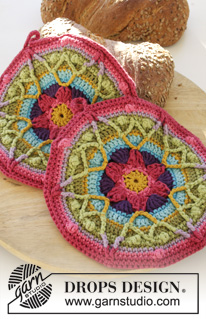
















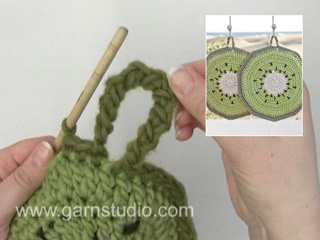
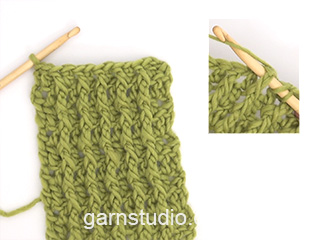










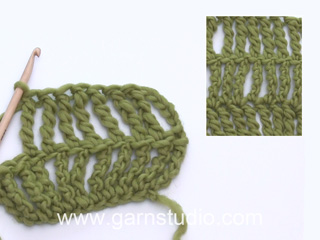









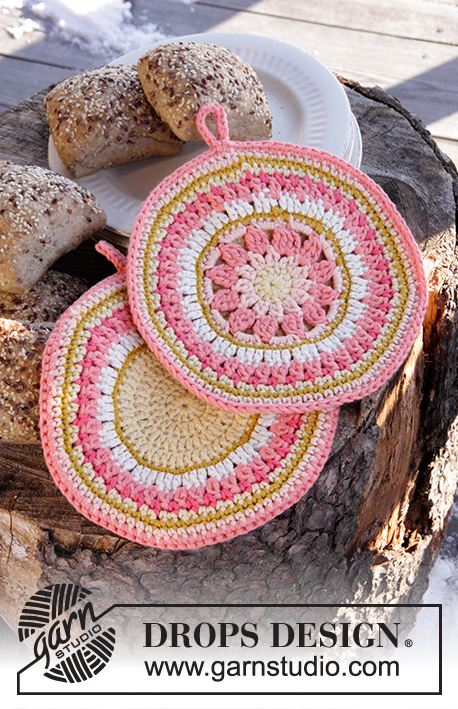
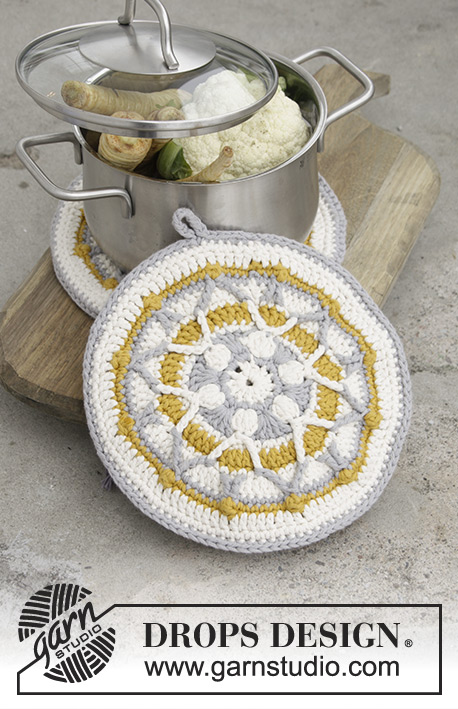
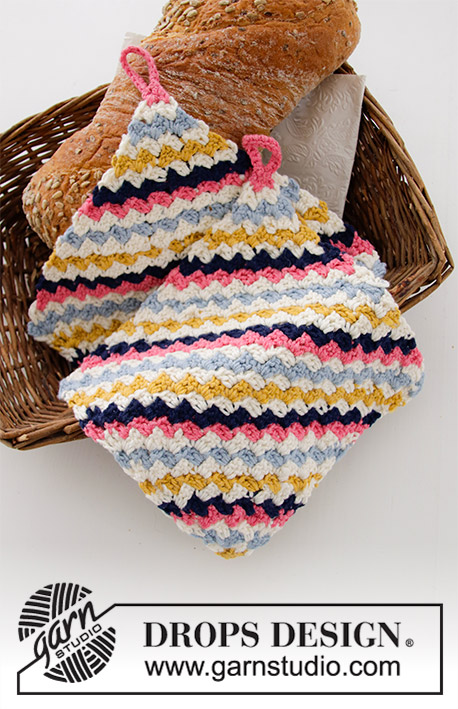

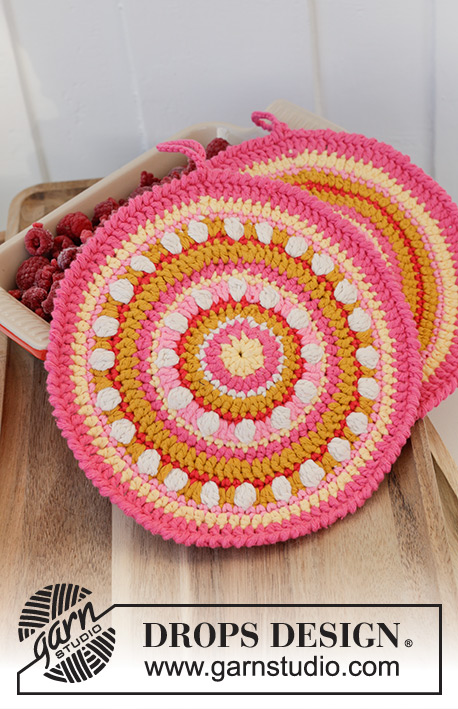






Comments / Questions (7)
Toer 3 eindig ik met een vaste, vervolgens moet ik toer 4 beginnen met een vaste in de eerste -L. Maar hoe kom ik daar? Moet ik toer 4 beginnen met 4 L ?
24.11.2018 - 21:24DROPS Design answered:
Dag Wilma,
Goede vraag (staat inderdaad niet goed aangegeven). Om aan het begin van de toer te komen na de laatste steek van toer 3 kun je het beste halve vaste haken langs de zijkant van het groepje stokjes.
28.11.2018 - 13:14Dobrý den, hlásím hotové obě chňapky, jsou nádherné. Jen víc utahuju, vyšly mi o 2cm v průměru menší. Děkuji za skvělý návod. Monika
31.07.2015 - 11:15DROPS Design answered:
Milá Moniko, díky za zprávu - návrhářská sekce byla pochvalou potěšena :-) A vy se na oplátku můžete těšit na další (věřím, že báječné) nápady, modely i návody. Hodně zdaru! Hana
01.08.2015 - 18:44Har det kommit någon rättelse till denna? Is there any errata for this pattern yet?
25.07.2015 - 09:43Hej Efter at have pillet op 3 gange, har jeg fundet en fejl i omgang 9. Der skal også springes en fm over under SPIDS. Ellers passer det ikke.
09.07.2015 - 19:55Helemaal gelijk. Toch het patroon niet goed gelezen.mijn fout was dat ik elke vaste maar 1 vaste deed ipv 2. Dank voor de reactie
01.06.2015 - 15:24Met dit patroon kom ik na de stokjes ronde op maar 60 stokjes uit ipv 66 die het patroon aangeeft. na 3 keer opnieuw beginnen geef ik het maar op. jammer
31.05.2015 - 13:56DROPS Design answered:
Hoi Rita. Dat is jammer. Ik heb toer 5 nagekeken en uitgerekend, en als je die correct haakt zou je op 66 steken uitkomen: haak 1 v in eerste v, 2 v in volgende l, 1 v in elke van de volgende 5 dstk, 2 v in volgende l, * 2 v in volgende v, 2 v in volgende l, 1 v in elke van de volgende 5 dstk, 2 v in volgende l *, herhaal van *-* nog 4 keer, 1 v in eerste v van het begin van de toer = 66 v = 1+2+5+2 (=10), *2+2+5+2* (aantal st tussen de sterretjes), herhaal in TOTAAL 5 keer (= 55), eindig met 1 v in de eerste v = 66
01.06.2015 - 13:56Hej! Varför går det inte att skriva ut diagrammet till Colorful Spring By Drops Design Extra 0-1103, när hela övriga mönstret fungerar perfekt. Vill så gärna virka dessa grytlappar men har inte tillgång till data alltid. Gäller alltså bara själva diagrammet. Hälsning Anna-Greth
09.04.2015 - 11:17DROPS Design answered:
Hei Anne-Greth. Du skulle kunne printe diagram ud uden problemer.
22.04.2015 - 15:58